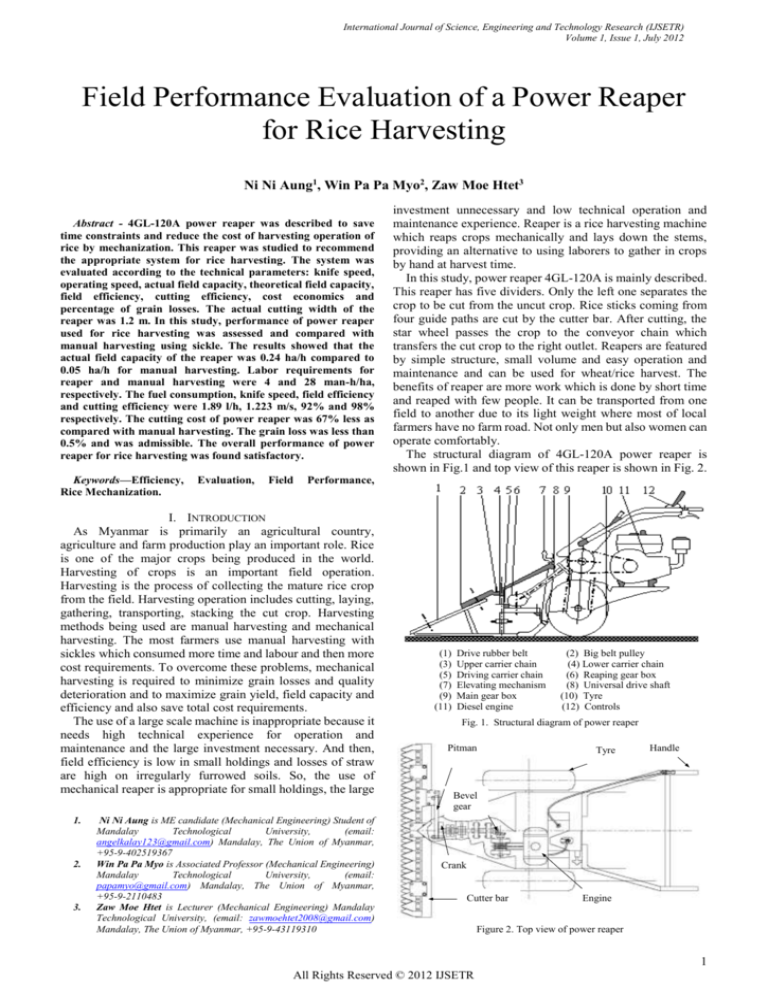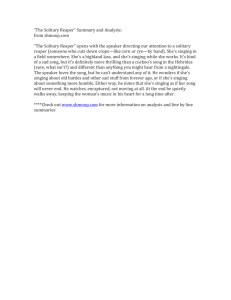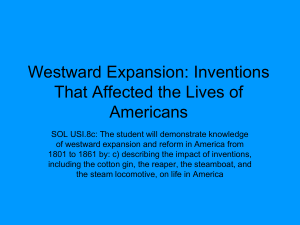
International Journal of Science, Engineering and Technology Research (IJSETR)
Volume 1, Issue 1, July 2012
Field Performance Evaluation of a Power Reaper
for Rice Harvesting
Ni Ni Aung1, Win Pa Pa Myo2, Zaw Moe Htet3
Abstract - 4GL-120A power reaper was described to save
time constraints and reduce the cost of harvesting operation of
rice by mechanization. This reaper was studied to recommend
the appropriate system for rice harvesting. The system was
evaluated according to the technical parameters: knife speed,
operating speed, actual field capacity, theoretical field capacity,
field efficiency, cutting efficiency, cost economics and
percentage of grain losses. The actual cutting width of the
reaper was 1.2 m. In this study, performance of power reaper
used for rice harvesting was assessed and compared with
manual harvesting using sickle. The results showed that the
actual field capacity of the reaper was 0.24 ha/h compared to
0.05 ha/h for manual harvesting. Labor requirements for
reaper and manual harvesting were 4 and 28 man-h/ha,
respectively. The fuel consumption, knife speed, field efficiency
and cutting efficiency were 1.89 l/h, 1.223 m/s, 92% and 98%
respectively. The cutting cost of power reaper was 67% less as
compared with manual harvesting. The grain loss was less than
0.5% and was admissible. The overall performance of power
reaper for rice harvesting was found satisfactory.
Keywords—Efficiency,
Rice Mechanization.
Evaluation,
Field
Performance,
I. INTRODUCTION
As Myanmar is primarily an agricultural country,
agriculture and farm production play an important role. Rice
is one of the major crops being produced in the world.
Harvesting of crops is an important field operation.
Harvesting is the process of collecting the mature rice crop
from the field. Harvesting operation includes cutting, laying,
gathering, transporting, stacking the cut crop. Harvesting
methods being used are manual harvesting and mechanical
harvesting. The most farmers use manual harvesting with
sickles which consumed more time and labour and then more
cost requirements. To overcome these problems, mechanical
harvesting is required to minimize grain losses and quality
deterioration and to maximize grain yield, field capacity and
efficiency and also save total cost requirements.
The use of a large scale machine is inappropriate because it
needs high technical experience for operation and
maintenance and the large investment necessary. And then,
field efficiency is low in small holdings and losses of straw
are high on irregularly furrowed soils. So, the use of
mechanical reaper is appropriate for small holdings, the large
1.
2.
3.
investment unnecessary and low technical operation and
maintenance experience. Reaper is a rice harvesting machine
which reaps crops mechanically and lays down the stems,
providing an alternative to using laborers to gather in crops
by hand at harvest time.
In this study, power reaper 4GL-120A is mainly described.
This reaper has five dividers. Only the left one separates the
crop to be cut from the uncut crop. Rice sticks coming from
four guide paths are cut by the cutter bar. After cutting, the
star wheel passes the crop to the conveyor chain which
transfers the cut crop to the right outlet. Reapers are featured
by simple structure, small volume and easy operation and
maintenance and can be used for wheat/rice harvest. The
benefits of reaper are more work which is done by short time
and reaped with few people. It can be transported from one
field to another due to its light weight where most of local
farmers have no farm road. Not only men but also women can
operate comfortably.
The structural diagram of 4GL-120A power reaper is
shown in Fig.1 and top view of this reaper is shown in Fig. 2.
Ni Ni Aung is ME candidate (Mechanical Engineering) Student of
Mandalay
Technological
University,
(email:
angelkalay123@gmail.com) Mandalay, The Union of Myanmar,
+95-9-402519367
Win Pa Pa Myo is Associated Professor (Mechanical Engineering)
Mandalay
Technological
University,
(email:
papamyo@gmail.com) Mandalay, The Union of Myanmar,
+95-9-2110483
Zaw Moe Htet is Lecturer (Mechanical Engineering) Mandalay
Technological University, (email: zawmoehtet2008@gmail.com)
Mandalay, The Union of Myanmar, +95-9-43119310
(1)
(3)
(5)
(7)
(9)
(11)
Drive rubber belt
Upper carrier chain
Driving carrier chain
Elevating mechanism
Main gear box
Diesel engine
(2) Big belt pulley
(4) Lower carrier chain
(6) Reaping gear box
(8) Universal drive shaft
(10) Tyre
(12) Controls
Fig. 1. Structural diagram of power reaper
Pitman
Tyre
Handle
Bevel
gear
Crank
Cutter bar
Engine
Figure 2. Top view of power reaper
1
All Rights Reserved © 2012 IJSETR
International Journal of Science, Engineering and Technology Research (IJSETR)
Volume 1, Issue 1, July 2012
Also, detailed technical specification of the 4GL-120A
power reaper is shown in Table I.
10˚
TABLE I
TECHNICAL SPECIFICATION OF A POWER REAPER
SI
No.
Parameters
Specifications
1
Manufacturer
China Jinwa Group Nanjing
Dajinshan Industrial Co.,Ltd and
Myanmar
2
Model
4GL-120A Power Reaper
3
1990 × 1490 × 985
4
Dimension L × W ×
H (mm)
Weight(kg)
5
Power unit
6
7
Working
capacity(ha/h)
Crop release
5 HP single cylinder 4-stroke,air
cooled diesel engine
0.2 to 0.4
8
Operation mode
Right side of the machine(Viewed
from rear)
Self-propelled walking type
9
Applicable crops
Rice and wheat
10
Total loss
<0.5%
11
Applicability
Dry and wet field
12
Cutting device
Reciprocating cutter bar
13
Cutting height(mm)
45 from ground level(adjustable)
14
Cutting width(mm)
1200
15
Travelling Device
Dough nut tyre wheel
Fig. 4. Preparation of power reaper depends on lodging angle
B. Operation Method
When coming across with protruded part of field land
where power reaper cannot operate, as field condition is
different, it is necessary to field edge reaping method, which
is adaptable to conditions.
Reaping method of left turn is the field standard
operation method as shown in Fig. 5.
220
Fig. 5. Left turn reaping method
Reciprocating reaping method is suited to right angled
quadrilateral long and narrow field as shown in Fig. 6.
Fig. 6. Reciprocating reaping method
In big field, reciprocating reaping parted from the center
will enhance the productivity as shown in Fig. 7.
II. FIELD PERFORMANCE TEST
This is carried out to obtain actual data on machine
performance, operating accuracy, work quality and
adaptability to varied crops and field conditions.
A. Preparation of Operation Field
In order to minimize the loss in reaping, before operation,
it is necessary to prepare the field.
Manually cropping on the four sides of field with width
of 20cm to prevent the loss due to the fact that machine
can’t reach the sides in reaping.
Manually cropping on four corners of field with square
of 2×2 m, so that machine can smoothly turn in field as
shown in Fig. 3.
Fig. 7. Parted reciprocating reaping method
In the field with irregular condition, first reap the short
beveled side as shown in Fig. 8.
Fig. 8. Reaping method in irregular field
2×2
Fig. 3. Preparation of operation field
The power reaper is applicable to the rice and wheat. The
wheat straw and rice stalk that have length within range
of 50~120cm and with the lodge angle of 10° above are
fitted to operation of power reaper as shown in Fig. 4.
When the lodging is serious, lateral reaping in one
direction should be used.
C. Changing of Direction of Reaper
When changing the direction of power reaper in small
sized field, driving backward and turning round reaping
2
All Rights Reserved © 2012 IJSETR
International Journal of Science, Engineering and Technology Research (IJSETR)
Volume 1, Issue 1, July 2012
method can be used, and gear shifting and through “driving
forward” ,”reversing”. Changing the direction using “driving
forward” method is a good method. The turning round
reaping method needs no gear shifting, but field edge area is
larger than that of using the “reversing”. In the wet field, the
turning round reaping method is more effective, however, the
field edge is wider as shown in Fig. 9. According to the
characteristics of tyre, it raises when moving forward and
sinks when reversing, so using the turning round reaping
method is more suitable.
F. Reaping Near Footpaths
When reaping near the footpaths, it must be careful to
prevent the raped crop from clogging the carrying portion of
getting caught in the carrying chain.
When the footpath is low, slightly raise the cutting height
so that reaped crop is delivered over the footpath as
shown in Fig. 12.
Driving
forward
Bank
Bank
Reversing
Bank
Bank
Reversing mode
Raise the cutting height
Fig. 12. Reaping with low footpath
Turning
round
Turning round method
Fig. 9. Changing direction of reaper
When the footpath is high or weedy, but higher cutting
height is not desired, reap by hand the few rows near the
footpath as shown in Fig. 13.
D. Changing the Handle Height of Reaper
For various height of person, the height of handle can be
adjusted by changing the position of holes on the handle as
shown in Fig. 10.
3. Bolt and nut
1. Bolt
4. Cutter bar
Reap the few rows by hand
Fig. 13. Reaping with high footpath
2. Bolt
Fig. 10. Changing handle height of reaper
E. Changing of Reaped Height
The reaped height requires to change for various height of
rice as shown in Fig. 11.
Reaped height in dry fields ranges from 10 cm to 30
cm.
Most suitable length of ears of rice ranges from 50 cm
to 100 cm. In case ears of rice are too short in length,
the sidelong feeding of them may be impracticable.
And in case they are too long in length, sidelong
feeding and releasing of them may fall into disorder,
and as the result of it, grains of rice may fall.
Reaped height can be easily changed by the handle up
and down motion. Because of wheel shaft bearings are
joined with frame.
III. EVALUATION OF FIELD PERFORMANCE OF A POWER
REAPER
The performance of power reaper was evaluated in the rice
field. Cutting mechanism consists of fixed lower knife and
reciprocating upper knife wherein its movement is controlled
by the crank connected to the gear box or belt drive. The
stroke length and the width of the standard type knife are 50
mm.
A. Knife Speed
Using the following equation, the knife speed was
calculated.
V
k
Sn
(1)
30
Where:
Vk = knife speed, m/s
S = length of stroke, m
n = crank speed, rpm
Fig. 11. Changing of reaped height
B. Operating Speed
On the outside of the long boundary of the test plot in field
operation, two poles 20 m apart (A, B) are placed
approximately in the middle of the test run as shown in Fig.
14.
3
All Rights Reserved © 2012 IJSETR
International Journal of Science, Engineering and Technology Research (IJSETR)
Volume 1, Issue 1, July 2012
E. Theoretical Field Capacity
Theoretical field capacity, computed rate of being able to
reap crop, was calculated based on the operating speed and
the width of the equipment.
20 m
A pole
B pole
FC
T
Reaper
Wc S
0
(5)
10
Where:
C pole
FCT = Theoretical field capacity, ha/h
Wc = Cutting width, m
S0 = Operating speed, km/h
D pole
Fig. 14. Measurement of operating speed
On the opposite side also, two poles are placed in similar
position, 20 m apart (C, D) so that all four poles form corners
of a rectangle, parallel to at least one long side of the test plot.
The speed will be calculated from the time required for the
machine to travel the distance (20m) between the assumed
line connecting two poles on opposite sides (A, C) and (B,
D). The easily visible point of the machine should be selected
for measuring the time. The operating speed was calculated
using the following equation.
S
0
F. Field Efficiency
Field efficiency is the ratio of the actual field capacity and
theoretical field capacity, expressed in percent.
FC
E
100
(6)
Where:
E
= Field Efficiency, %
FCA = Actual field capacity, ha/h
FCT = Theoretical field capacity, ha/h
3.6 D
(2)
T
Where:
S0 = operating speed, km/h
D = harvesting distance, m
T = harvesting time, s
Speed ratio was the average reciprocating knife speed over
operating speed.
G. Cutting Efficiency
Cutting efficiency was calculated based on the number of
rice plants in 20m length was counted before operation and
the plants left in same 20m length were counted after
operation.
CE
C. Fuel Consumption
Fuel consumption, in litres per hour (L/h), is the amount of
refueling for the test. In this method, before the start of each
test trial, the fuel tank shall be filled to its capacity and after
each test trial, the tank shall be refilled using graduated
cylinder. When filling up the tank, keep the tank horizontal so
as not to leave empty space in the tank.
Fc
q
(3)
t
Where:
CE
W1
W2
A
T
(4)
H. Cost Economics
The cost of mechanical harvesting can be calculated on
basis of fuel required for the operation, labor charges, etc and
was compared with the manual operations.
Where:
Cm
Cr
Cm Cr
100
(8)
= Harvesting cost by manual, K/day
= Harvesting cost by reaper, K/day
I. Percentage of Grain Losses
Percentage of grain losses was obtained by the following
equation.
P
gl
G y Wg
T
0
Where:
FCA
AT
To
(7)
Cm
D. Actual Field Capacity
Actual field capacity, actual rate of being able to reap crop,
was calculated based on area covered, and actual time. The
actual time pertains to the total operating time which includes
the time spent for turning at the headland, adjustment of
machine and machine trouble.
100
= Cutting Efficiency, %
= Number of plants before cutting
= Number of plants left after cutting
Less Cost
Fc = Fuel consumption, l/h
q = quantity of fuel consumed, li
t = consumption time, hr
A
W W
1
2
W
1
Where:
FC
A
FC
T
= actual field capacity, ha/h
= area covered during test, ha
= total operating time, h
100
(9)
Gy
Where,
Pgl = Percentage of grain losses, %
Wg = Weight of output grain, kg/ha
Gy = Weight grain yield, kg/ha
4
All Rights Reserved © 2012 IJSETR
International Journal of Science, Engineering and Technology Research (IJSETR)
Volume 1, Issue 1, July 2012
IV. RESULTS
Rice was harvested using 4GL-120A power reaper.
Performance data were collected to assess knife speed,
operating speed, field capacity, field efficiency, cutting
efficiency, losses due to machine operation, fuel
consumption and labor requirement. Rice is harvested when
20% grain moisture. The moisture content of grain at the time
of harvesting found 20% to 25% (wb). The knife speed, field
efficiency and cutting efficiency were found to be 1.223 m/s,
92% and 98% respectively. As crank speed increased, the
knife speed also increased. According to rice density, rice
was cut at different operating speeds for checking reaper
motion resistance, running conditions and harvesting quality.
The operating speed was higher in low rice density and lower
in high density. The reaper shall be operated at the speed of 2
km/h to 5 km/h. At operating speeds greater than 5 km/h,
blockage was noticed on the cutter bar unit due to the high
density of the rice and insufficient engine power. To prevent
blockage, harvesting was performed at operating speeds less
than 5 km/h. The theoretical field capacity increased and the
fuel consumption decreased as operating speed increased.
The fuel consumption decreased as predicted at high
operating speeds due to the constant engine speed during
harvesting. In addition, at high operating speeds, the field
efficiency decreased because the total time lost did not
increase proportionally to the increase in the harvesting time.
The cutting efficiency decreased as number of plants left after
cutting increased. The cutting efficiency also varied due to
low speed of blade provided more torque at the edge of blade
so stems cut easily but at high speed, low torque it was
difficult to cut the stems. The cutting cost of power reaper
was 67% less than with manual harvesting. Percentage of
grain losses using reaper was 0.4%. The field losses
depended on variety, maturity, field condition, speed of
machine and time of harvest.
The performance characteristics of the power reaper were
shown in Table II.
V. CONCLUSIONS
The overall performance of reaper was quite satisfactory.
The average cutting efficiency and actual field capacity was
found 98% and 0.24 ha/h respectively. Time taken to harvest
0.6 acre or 0.24 hectare of rice area was about 1 hour and the
fuel consumption of reaper was 1.89 l/h. The price of reaper
was K 990,000. The local supplier of the reaper only sells the
machine and has no spare parts. The maximum area on which
the reaper operated in a year is 288 acres or 120 hectares. The
cost of manual harvesting was K 30000/day as against
K10000/day in the case of mechanical harvesting. If the
machine is used for 60 hectares or 30 days, the cost of
mechanical harvesting would be K 300,000 (without fuel cost
and maintenance) as compared to K 900,000 in the case of
manual harvesting. Thus it is feasible to reduce the cost of
harvesting operation of rice be mechanization to almost
one-third the cost of manual harvesting. The farmers are
convinced that the cutting of crop by reaper is much faster
than manual cutting by sickle. So, power reaper is more
suitable for farmers and other customers. It is also suitable for
mountain and hilly areas. The operation was smooth, without
noise and any exhaustion to the operator. Therefore, the
farmer or labor in agricultural field is very comfortable for
reaping with machine.
ACKNOWLEDGMENT
The author would like to thank Dr Win Pa Pa Myo,
Associated Professor, Department of Mechanical
Engineering, Mandalay Technology University, for her
supervision, support, guidance and encouragement
throughout this study.
The author would like to thank U Zaw Moe Htet for his
comments and kindness.
TABLE II
COMPARATIVE PERFORMANCE CHARACTERISTICS OF POWER REAPER WITH
MANUAL HARVESTING IN TRANSPLANTED PADDY
SI
No
.
1
Parameters
Power source
Rice variety
Date of nursery raised
Date of transplanting
Date of harvesting
Study area(ha)
2
3
4
5
6
7
8
9
10
11
12
13
14
15
16
Speed of
operation(km/h)
Width of operation(cm)
Time required(h/ha)
Actual field
capacity(ha/h)
Theoretical field
capacity(ha/h)
Field efficiency (%)
Cutting efficiency (%)
Labor requirement /day
(including collecting
and building)
Fuel consumption(L/h)
Cost of
operation(K/day)
NA = Not Applicable
Harvesting Methods
Mechanical
Manual
5 HP diesel
engine
Manawthukha
22-11-2013
7-1-2014
7-5-2014
0.24
2.18
Man power
Manawthukha
22-11-2013
7-1-2014
7-5-2014
0.24
NA
120
4 h 10 min
0.24
NA
20 h
0.05
0.262
0.051
92
98
4
98
97
12
1.89
10000
NA
30000
REFERENCES
[1]
Operation Manual of 4GL-120A Power Reaper, China Jinwa Group
Nanjing Dajinshan Industrial Co.,Ltd
[2] PHILIPPINE AGRICULTURAL ENGINEERING STANDARD
PAES 213: 2004, Agricultural Machinery – Rice Reaper – Methods of
Test
[3] Victoria ROBERT, “Study on the Performance and Economics of
Binder and Reaper at Different Cutting Heights”, Department of
Agriculture Sabah, Malaysia.
[4] M.V.MANJUNATHA, B.G.MASTHANA REDDY,
S. D.
SHASHIDHAR AND V. R. JOSHI, “Field Performance Evaluation of
Vertical Conveyor Paddy Reaper”, Department of Agricultural
Engineering, University of Agricultural Sciences, India.
[5] A. Celik, “Design and Operating Characteristics of a Push Type Cutter
Bar Mower”, Ataturk University, Faculty of Agriculture, Department
of Agricultural Machinery, 25240 Erzurum, Turkey.
[6] Atul R. Dange, “Development and Performance Evaluation of Tractor
Front Mounted Pigeon Pea Stem Cutter”, Central Research Institute for
Dryland Agriculture, Hyderabad-500059 (A.P.), India.
[7] MOHAMMAD REZA ALIZADEH, IRAJ BAGHERI AND MIR
HUSSEIN PAYMAN, “Evaluation of a Rice Reaper Used for
Rapeseed Harvesting”, Rice Research Institute of Iran.
[8] K.G. KUMAR AND M.CHOWDE GOWDA, “Power Tiller Front
Mounted Reaper for Finger Millet Harvesting”, Division of Agricltural
Engineering, University of Agricultural Sciences,Bangalore-560 065.
[9] T.GURUSWAMY, S.R. DESAI, M. VEERANAGOUDA AND R.D.
BARKER, “Performance Evaluation of Vertical Conveyor Reaper
Windrower”, College of Agricultural Engineering, Raichur.
[10] B.C.Parida, “Evaluation, Constraints and Acceptability of Different
Types of Vertical Conveyer Reaper for Harvesting Rice in Coastal
Orissa, India”, Agricultural Engineering Division, Central Rice
Research Insitute, Cuttack, Orissa, India.
5
All Rights Reserved © 2012 IJSETR







